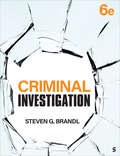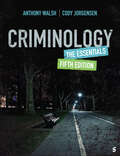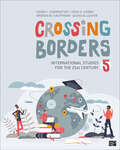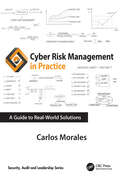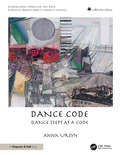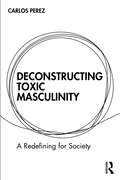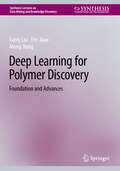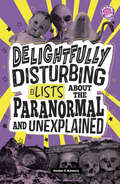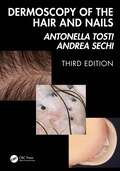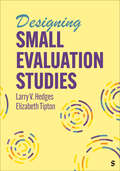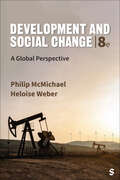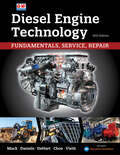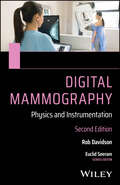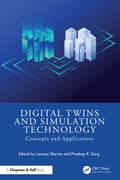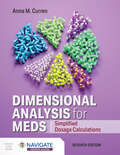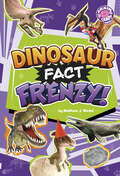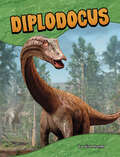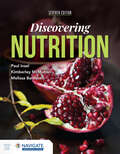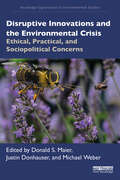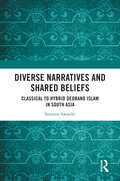- Table View
- List View
Criminal Investigation
by Steven G. BrandlCriminal Investigation, Sixth Edition offers a comprehensive and engaging examination of criminal investigation and the vital role criminal evidence plays in the process. Written in a straightforward manner, the text focuses on the five critical areas essential to understanding criminal investigations: background and contextual issues, criminal evidence, legal procedures, evidence collection procedures, and forensic science. In this brand new edition, author Steven G. Brandl goes beyond a simple how-to on investigative procedures, and draws from fascinating modern research, comprehensive cases, and criminal evidence to demonstrate their importance in the real world of criminal justice, providing students with practical insights into the field of criminal investigation.
Criminal Investigation
by Steven G. BrandlCriminal Investigation, Sixth Edition offers a comprehensive and engaging examination of criminal investigation and the vital role criminal evidence plays in the process. Written in a straightforward manner, the text focuses on the five critical areas essential to understanding criminal investigations: background and contextual issues, criminal evidence, legal procedures, evidence collection procedures, and forensic science. In this brand new edition, author Steven G. Brandl goes beyond a simple how-to on investigative procedures, and draws from fascinating modern research, comprehensive cases, and criminal evidence to demonstrate their importance in the real world of criminal justice, providing students with practical insights into the field of criminal investigation.
Criminology: The Essentials
by Anthony Walsh Cody JorgensenIn Criminology: The Essentials, authors Anthony Walsh and Cody Jorgensen introduce students to major theoretical perspectives and criminology topics in a concise, easy-to-read format. This straightforward overview of the major subject areas in criminology thoroughly covers the most up-to-date advances in theory and research, while challenging students to consider the applications of these theories as well as their policy implications. Updates to the Fifth Edition include new topics and developments in criminology, such as racial disparities in arrest rates, insights from the Big Five personality traits, cognitive behavioral therapy, gun violence and policy, and the opioid epidemic. It also offers detailed evaluations of theories to deepen student understanding and foster engaging classroom discussions.
Criminology: The Essentials
by Anthony Walsh Cody JorgensenIn Criminology: The Essentials, authors Anthony Walsh and Cody Jorgensen introduce students to major theoretical perspectives and criminology topics in a concise, easy-to-read format. This straightforward overview of the major subject areas in criminology thoroughly covers the most up-to-date advances in theory and research, while challenging students to consider the applications of these theories as well as their policy implications. Updates to the Fifth Edition include new topics and developments in criminology, such as racial disparities in arrest rates, insights from the Big Five personality traits, cognitive behavioral therapy, gun violence and policy, and the opioid epidemic. It also offers detailed evaluations of theories to deepen student understanding and foster engaging classroom discussions.
Crossing Borders: International Studies for the 21st Century
by Harry I. Chernotsky Heidi H. Hobbs Brenda M. Kauffman Sasha AllgayerCrossing Borders: International Studies for the 21st Century provides a framework to help students understand world issues, built upon an understanding of the many borders that define the international system. In the Fifth Edition, renowned authors Harry I. Chernotsky and Heidi H. Hobbs are joined by new coauthors Brenda M. Kauffman and Sasha Allgayer to address many of the different fields that constitute international studies—geography, politics, economics, sociology, and anthropology—and give instructors a starting point from which they can pursue their own disciplinary interests. In addition to developing a better understanding of the world, students also learn how to increase their own global engagement through study abroad, internships, and career options.
Crossing Borders: International Studies for the 21st Century
by Harry I. Chernotsky Heidi H. Hobbs Brenda M. Kauffman Sasha AllgayerCrossing Borders: International Studies for the 21st Century provides a framework to help students understand world issues, built upon an understanding of the many borders that define the international system. In the Fifth Edition, renowned authors Harry I. Chernotsky and Heidi H. Hobbs are joined by new coauthors Brenda M. Kauffman and Sasha Allgayer to address many of the different fields that constitute international studies—geography, politics, economics, sociology, and anthropology—and give instructors a starting point from which they can pursue their own disciplinary interests. In addition to developing a better understanding of the world, students also learn how to increase their own global engagement through study abroad, internships, and career options.
Cyber Risk Management in Practice: A Guide to Real-World Solutions (Security, Audit and Leadership Series)
by Carlos MoralesCyber Risk Management in Practice: A Guide to Real-World Solutions is your companion in the ever-changing landscape of cybersecurity. Whether you're expanding your knowledge or looking to sharpen your existing skills, this book demystifies the complexities of cyber risk management, offering clear, actionable strategies to enhance your organization's security posture. With a focus on real-world solutions, this guide balances practical application with foundational knowledge.Key Features: Foundational Insights: Explore fundamental concepts, frameworks, and required skills that form the backbone of a strong and pragmatic cyber risk management program tailored to your organization’s unique needs. It covers everything from basic principles and threat modeling to developing a security-first culture that drives change within your organization. You’ll also learn how to align cybersecurity practices with business objectives to ensure a solid approach to risk management. Practical Application: Follow a hands-on step-by-step implementation guide through the complete cyber risk management cycle, from business context analysis to developing and implementing effective treatment strategies. This book includes templates, checklists, and practical advice to execute your cyber risk management implementation, making complex processes manageable and straightforward. Real-world scenarios illustrate common pitfalls and effective solutions. Advanced Strategies: Go beyond the basics to achieve cyber resilience. Explore topics like third-party risk management, integrating cybersecurity with business continuity, and managing the risks of emerging technologies like AI and quantum computing. Learn how to build a proactive defense strategy that evolves with emerging threats and keeps your organization secure. “Cyber Risk Management in Practice: A Guide to Real-World Solutions by Carlos Morales serves as a beacon for professionals involved not only in IT or cybersecurity but across executive and operational roles within organizations. This book is an invaluable resource that I highly recommend for its practical insights and clear guidance” – José Antonio Fernández Carbajal. Executive Chairman and CEO of FEMSA
Dance Code: Dance Steps As A Code
by Anna UrsynMany people relax when coding is introduced as a language, rather than math. Even if someone creates alone, the technology involved in the process has already been developed by somebody else. Even one person's business requires professional input from others, and collaborations are often performed online. This book mixes experiences in art, coding, music, dance, choreography, video, and stage design. Dances have unique structures and so do computer codes. In both disciplines, steps are applied following patterns, and are guided by rules and restrictions. The rules obey conditions. The Dance Code script aims to make coding less feared by readers when talking with coders on the job and typing better prompts when using artificial intelligence. In this book, a dramatized, choreographed story unfolds technical information about coding and dancing.The Dance Code script tells the story of an online interaction between a coder and a prima ballerina, resulting in a shared understanding of their respective fields. An exchange between a coder and a dancer may inspire new ways to look at visually presenting knowledge through dancing, performing, or choreographed movement. Hence, the audience learns without studying.It is a part of the “Knowledge Through the Arts” series, consisting of:Dance Code - Dance Steps as a CodeNew Storytelling - Learning Through MetaphorsCode Appreciation - Reshaping KnowledgeNature Appreciation - Knowledge as Art
Deconstructing Toxic Masculinity: A Redefining for Society
by Carlos PerezThis accessible book explores toxic masculinity, looking at how to define it, and how we can and should challenge its spread. This book draws on Derrida’s deconstruction, using the philosophical lens to deconstruct what toxic masculinity means and to better understand its significance for our society. It focuses on how harmful aspects of masculinity spread, infiltrate, and intoxicate our societies and how existing structures allow aspects of harmful masculinity to become toxic. This book also features discussions and analysis of participants’ lived experiences of masculinities, alongside the author’s reflections. It explores the relevance of toxic masculinity in work environments, politics, relationships, and gender roles and seeks to challenge and mitigate its damages for everyone. Encouraging critical thinking and understanding of healthier ways of being for all, this timely book will be of interest to therapists, counselors, teachers, and practitioners of family studies. It will also be useful reading for students in the fields of psychology, gender studies, sociology, and related fields.
Deep Learning for Polymer Discovery: Foundation and Advances (Synthesis Lectures on Data Mining and Knowledge Discovery)
by Gang Liu Meng Jiang Eric InaeThis book presents a comprehensive range of topics in deep learning for polymer discovery, from fundamental concepts to advanced methodologies. These topics are crucial as they address critical challenges in polymer science and engineering. With a growing demand for new materials with specific properties, traditional experimental methods for polymer discovery are becoming increasingly time-consuming and costly. Deep learning offers a promising solution by enabling rapid screening of potential polymers and accelerating the design process. The authors begin with essential knowledge on polymer data representations and neural network architectures, then progress to deep learning frameworks for property prediction and inverse polymer design. The book then explores both sequence-based and graph-based approaches, covering various neural network types including LSTMs, GRUs, GCNs, and GINs. Advanced topics include interpretable graph deep learning with environment-based augmentation, semi-supervised techniques for addressing label imbalance, and data-centric transfer learning using diffusion models. The book aims to solve key problems in polymer discovery, including accurate property prediction, efficient design of polymers with desired characteristics, model interpretability, handling imbalanced and limited labeled data, and leveraging unlabeled data to improve prediction accuracy.
Delightfully Disturbing Lists About the Paranormal and Unexplained
by Heather E. SchwartzSpooky season can be all year long when the scariest, most spine-tingling facts are collected in this book of delightfully disturbing lists. Chapters make the content event more digestible. Full-color images and inviting designs will engage readers’ minds and get them excited to learn more.
Dermoscopy of the Hair and Nails 3e
by Antonella Tosti Andrea SechiThis new edition of a bestselling text almost amounts to a completely new book, with over 750 figures of common and uncommon disorders, including new chapters on trichoscopy of hair transplantation, teletrichoscopy, and trichoscopy of the shaved scalp. The chapters also list the key clues that are important to help the practitioner reach the correct diagnosis about problems with hair or nails."Numerous high-quality photos are helpful in demonstrating key features" (Doody’s Reviews) [of the previous edition]
Designing Small Evaluation Studies
by Larry V. Hedges Elizabeth Tipton"The book will be an important addition to instruction in designs for causal inference in the field of education. It is long overdue." - Thomas J. Lipscomb, The University of Southern Mississippi This text describes how to design and analyze small efficacy or evaluation studies, typically carried out as part of the development of programs or interventions in areas such as education. The problem facing many researchers is how to design a study that is as small as possible, yet big enough to yield relatively unambiguous evidence about an intervention’s average effect. This text begins with an overview of validity, causal inference, statistics, effect sizes, and measurement. The authors then focus on designs for small, randomized trials, followed by a section on non-randomized causal designs: here they focus on three designs most useful for small studies including the non-equivalent control group, difference-in-difference, and interrupted time series designs. The final section summarizes the book, compares designs, discusses approaches to choosing a design, and provides guidance on reporting. Five case examples are used throughout the book to illustrate the material and there is a glossary of terms and concepts.
Designing Small Evaluation Studies
by Larry V. Hedges Elizabeth Tipton"The book will be an important addition to instruction in designs for causal inference in the field of education. It is long overdue." - Thomas J. Lipscomb, The University of Southern Mississippi This text describes how to design and analyze small efficacy or evaluation studies, typically carried out as part of the development of programs or interventions in areas such as education. The problem facing many researchers is how to design a study that is as small as possible, yet big enough to yield relatively unambiguous evidence about an intervention’s average effect. This text begins with an overview of validity, causal inference, statistics, effect sizes, and measurement. The authors then focus on designs for small, randomized trials, followed by a section on non-randomized causal designs: here they focus on three designs most useful for small studies including the non-equivalent control group, difference-in-difference, and interrupted time series designs. The final section summarizes the book, compares designs, discusses approaches to choosing a design, and provides guidance on reporting. Five case examples are used throughout the book to illustrate the material and there is a glossary of terms and concepts.
Development and Social Change: A Global Perspective
by Philip McMichael Heloise WeberDevelopment and Social Change explores the historical, socio-political, and ecological aspects of development. The Eighth Edition critically engages with the concept of development, tracing its roots and examining its implications in the contemporary world. Authors Philip McMichael and Heloise Weber use case studies and examples to help describe a complex world in transition. Students are encouraged to see global development as a contested historical project. By showing how development stems from unequal power relationships between and among peoples and states, often with planet-threatening environmental outcomes, it enables readers to reflect on the possibilities for more just social, ecological and political relations.
Development and Social Change: A Global Perspective
by Philip McMichael Heloise WeberDevelopment and Social Change explores the historical, socio-political, and ecological aspects of development. The Eighth Edition critically engages with the concept of development, tracing its roots and examining its implications in the contemporary world. Authors Philip McMichael and Heloise Weber use case studies and examples to help describe a complex world in transition. Students are encouraged to see global development as a contested historical project. By showing how development stems from unequal power relationships between and among peoples and states, often with planet-threatening environmental outcomes, it enables readers to reflect on the possibilities for more just social, ecological and political relations.
Diesel Engine Technology
by James P. Mack Jason A. Daniels Mark A. DeHart J. Gene Choe Kevin D. ViethDiesel Engine Technology covers the design, construction, operation, diagnosis, service, and repair of both mobile and stationary diesel engines. Content relates to on- and off-road vehicles, as well as marine, agricultural, and industrial applications. This text is a valuable resource for anyone involved in the service and repair of diesel engines, as well as those preparing for ASE Medium/Heavy Truck Test T2—Diesel Engines, Test T6—Electrical/Electronic Systems, and Test T8—Preventive Maintenance Inspection.
Digital Mammography: Physics and Instrumentation
by Rob DavidsonAn authoritative and up-to-date discussion of digital mammography fundamentals The newly revised second edition of Digital Mammography: Physics and Instrumentation delivers an expert discussion of all things digital mammography. From an explanation of how mammography plays an important role in cancer detection and treatment to practical discussions of mammography image formation, you’ll find analysis of the most recent advances in digital breast tomosynthesis and photon counting mammography. Readers will also discover: Complete treatments of mammographic instrumentation and physicsA thorough introduction to image quality optimization techniquesComprehensive explorations of new artificial intelligence applications in mammographyValuable information about how radiation dose is relevant to patient safety and diagnostics Perfect for mammography radiologic technologists and diagnostic radiographers, Digital Mammography: Physics and Instrumentation will also benefit breast clinicians, trainee radiologists, and students of medical imaging and radiography.
Digital Twins and Simulation Technology: Concepts and Applications
by Lavanya Sharma and Pradeep K. GargThis book provides a comprehensive overview of the concept of digital twins, emphasising its strategic importance across various commercial domains. This book covers the fundamentals, data requirements, tools, and technologies essential for understanding and implementing digital twins. It discusses how digital twins are used for running simulations, analysing performance issues, and generating potential improvements to optimise business processes. The book explores the architecture, historical background, and real-time applications in sectors including urban planning, healthcare, smart cities, and manufacturing. Explains digital twin technology, including its core principles, architecture, and how it replicates physical objects in virtual platforms, in detail Covers the data types and tools necessary for creating and maintaining digital twins, including sensors, data processing systems, and integration methodologies Explores technologies such as Computer Vision, IoT, AI, ML, 5G, AR, and VR that drive the functionality and application of digital twins Analyses practical applications in diverse sectors like urban planning, smart cities, healthcare, manufacturing operations, and power-generation equipment, showcasing real-world use cases and benefits Examines real-time challenges and limitations associated with implementing digital twin technology, providing a balanced view of its capabilities and constraints It is a reference book for researchers, scholars, and students who are working or interested in learning about digital twin technology.
Dimensional Analysis for Meds: Simplified Dosage Calculations
by Anna M. CurrenDosage calculation can be very challenging and intimidating for students. However, renowned author and educator, Anna Curren applies her experience, knowledge, and proven method to take the fear-factor out of manual math in Dimensional Analysis: Simplified Dosage Calculations, Seventh Edition. She breaks down the subject using dimensional analysis which reduces all calculations into a single, easy-to-solve equation. Furthermore, her conversational writing style brings the students to a safe place in the often-intimidating realm of math. The updated Seventh Edition presents only the essential information. The first section includes a chapter with an overview of the metric system; as Curren states, 98% of all calculations involve metric measures. The text is structured to feature content in small instructional steps followed by assessments to reinforce what has been learned.
Dinosaur Fact Frenzy!
by Mathew J. WedelThere’s a DINOSAUR FACT FRENZY headed your way! Did you know that Velociraptors were about the same size as a turkey? Or that Incisivosaurus had big front teeth, like a beaver, that it used for cutting plants? Dozens of bite-size facts are paired with fun dinosaur images, welcoming in even the most reluctant readers. Whether kids are in the mood to browse or to devour a book from cover to cover, even a dedicated dino fan is sure to learn something surprising as they flip through these pages.
Diplodocus
by Nick HunterYoung readers are full of questions about their favorite dinosaurs! What did Diplodocus eat? And how did it use its tail to protect itself from predators? Readers can get all the facts on this plant-eating, long-necked dinosaur. Engaging text and images make this book a great choice for information to use in a report or just to read for fun.
Discovering Nutrition
by Melissa Bernstein Kimberley McMahon Dr. Paul InselIncorporating the latest research and dietary guidelines, Discovering Nutrition, Seventh Edition introduces students to the fundamentals of nutrition with an engaging and personalized approach. Written with a diverse student population of nutrition majors and non-majors in mind, this text focuses on teaching behavior change and personal decision making with an emphasis on how our nutritional behaviors influence lifelong personal health and wellness, while also presenting up-to-date scientific concepts in several innovative ways. Thoroughly updated, the new seventh edition covers current nutrition topics of interest such as personalized nutrition, nutrigenomics, the obesogenic environment, gut health, microbiome, plant-based diet, functional foods, bioavailability, nutrition density, and gut microbiome. Feature boxes such as the new Lifestyle Medicine, Why Is This Important? Quick Bites, and more, ensure students learn practical nutrition information.
Disruptive Innovations and the Environmental Crisis: Ethical, Practical, and Sociopolitical Concerns (Routledge Explorations in Environmental Studies)
by Michael Weber Donald S. Maier Justin DonhauserThis book probes the ethical, practical, and sociopolitical implications of leveraging innovative and disruptive means to address the world’s various environmental crises.Packed with keen observations and analyses, the volume brings together research from seasoned scholars and rising stars to cast important new light on urgent issues engendered by humankind’s disruption of environments, such as climate change and biodiversity loss. It tackles the question of exactly what has been disrupted in the world—environmentally, economically, socially, and politically. It also examines an assortment of innovative interventions that aim to address disruptions and explores the question of what further disruptions may lurk behind assorted innovative interventions intended to address already existing disruptions. Chapters wrestle with the social, ethical, and ecological implications of disruptions, both pre-existing and those brought about by interventions, connected with deploying artificial gene drives, substituting robotic pollinators for living ones, synthesizing organisms to replace ones lost, installing economic regimes that work well for both citizens and the environment, making science subservient to non-scientific commitments, involving citizens in environmentally consequential decisions, choosing scientific and technological projects that most promise immediate practical payoff, and ensuring that respect for human rights is part and parcel of any technology-infused project. These discussions draw on a rich mix of science, philosophy of science, political theory, economics, sociology, network theory, ethics, and theories of justice and human rights.This book will be of great interest to students and scholars of environmental science, environmental decision-making, ecology, climate change, environmental philosophy, and the philosophy of science.
Diverse Narratives and Shared Beliefs: Classical to Hybrid Deoband Islam in South Asia
by Soumya AwasthiThis book delves into the intricate tapestry of Deoband Islam in India, Pakistan, and Afghanistan. Challenging simplistic narratives, it unveils the nuanced reality of Deoband Islam, revealing a diverse range of perspectives within the movement. It illuminates the movement's historical, social, and philosophical dimensions. It explores the movement's relationship with societal transformation and communal identity and its impact on the geopolitical dynamics of South Asia.The book offers a distinctive perspective on the Deoband school of thought in Islam by systematically categorising it into three distinct regional variants, each reflecting the unique socio-political context of its environment. The focus is on the Deoband school of thought, a strand within Sunni Islam that adheres to the philosophical framework of Ashari Maturidi. Critically examining its teachings uncovers the complexities and contradictions that shape Deobandi's thought, challenging popular assumptions and providing a fresh understanding. It also highlights the voices of Deobandi scholars and organisations who unequivocally denounce terrorism and actively work to counter radicalisation. Acknowledging their efforts, the book underscores the potential for dialogue and cooperation in promoting peace and understanding.With its comprehensive approach and thought-provoking analysis, this book is essential for scholars, policymakers, political science departments, theology, sociology, international relations, security studies, and South Asian studies.
